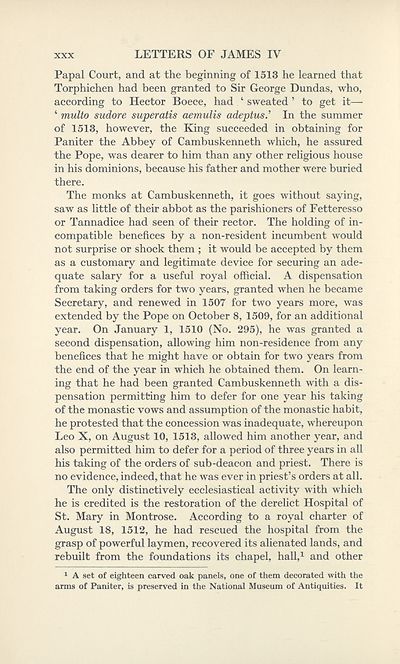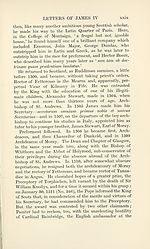Series 3 > Letters of James the Fourth, 1505-1513
(37) Page xxx
Download files
Complete book:
Individual page:
Thumbnail gallery: Grid view | List view

XXX
LETTERS OF JAMES IV
Papal Court, and at the beginning of 1513 he learned that
Torphichen had been granted to Sir George Dundas, who,
according to Hector Boece, had ‘ sweated ’ to get it—
‘ multo sudore superatis aemulis adeptus.' In the summer
of 1513, however, the King succeeded in obtaining for
Paniter the Abbey of Cambuskenneth which, he assured
the Pope, was dearer to him than any other religious house
in his dominions, because his father and mother were buried
there.
The monks at Cambuskenneth, it goes without saying,
saw as little of their abbot as the parishioners of Fetteresso
or Tannadice had seen of their rector. The holding of in¬
compatible benefices by a non-resident incumbent would
not surprise or shock them ; it would be accepted by them
as a customary and legitimate device for securing an ade¬
quate salary for a useful royal official. A dispensation
from taking orders for two years, granted when he became
Secretary, and renewed in 1507 for two years more, was
extended by the Pope on October 8, 1509, for an additional
year. On January 1, 1510 (No. 295), he was granted a
second dispensation, allowing him non-residence from any
benefices that he might have or obtain for two years from
the end of the year in which he obtained them. On learn¬
ing that he had been granted Cambuskenneth with a dis¬
pensation permitting him to defer for one year his taking
of the monastic vows and assumption of the monastic habit,
he protested that the concession was inadequate, whereupon
Leo X, on August 10, 1513, allowed him another year, and
also permitted him to defer for a period of three years in all
his taking of the orders of sub-deacon and priest. There is
no evidence, indeed, that he was ever in priest’s orders at all.
The only distinctively ecclesiastical activity with which
he is credited is the restoration of the derelict Hospital of
St. Mary in Montrose. According to a royal charter of
August 18, 1512, he had rescued the hospital from the
grasp of powerful laymen, recovered its alienated lands, and
rebuilt from the foundations its chapel, hall,1 and other
1 A set of eighteen carved oak panels, one of them decorated with the
arms of Paniter, is preserved in the National Museum of Antiquities. It
LETTERS OF JAMES IV
Papal Court, and at the beginning of 1513 he learned that
Torphichen had been granted to Sir George Dundas, who,
according to Hector Boece, had ‘ sweated ’ to get it—
‘ multo sudore superatis aemulis adeptus.' In the summer
of 1513, however, the King succeeded in obtaining for
Paniter the Abbey of Cambuskenneth which, he assured
the Pope, was dearer to him than any other religious house
in his dominions, because his father and mother were buried
there.
The monks at Cambuskenneth, it goes without saying,
saw as little of their abbot as the parishioners of Fetteresso
or Tannadice had seen of their rector. The holding of in¬
compatible benefices by a non-resident incumbent would
not surprise or shock them ; it would be accepted by them
as a customary and legitimate device for securing an ade¬
quate salary for a useful royal official. A dispensation
from taking orders for two years, granted when he became
Secretary, and renewed in 1507 for two years more, was
extended by the Pope on October 8, 1509, for an additional
year. On January 1, 1510 (No. 295), he was granted a
second dispensation, allowing him non-residence from any
benefices that he might have or obtain for two years from
the end of the year in which he obtained them. On learn¬
ing that he had been granted Cambuskenneth with a dis¬
pensation permitting him to defer for one year his taking
of the monastic vows and assumption of the monastic habit,
he protested that the concession was inadequate, whereupon
Leo X, on August 10, 1513, allowed him another year, and
also permitted him to defer for a period of three years in all
his taking of the orders of sub-deacon and priest. There is
no evidence, indeed, that he was ever in priest’s orders at all.
The only distinctively ecclesiastical activity with which
he is credited is the restoration of the derelict Hospital of
St. Mary in Montrose. According to a royal charter of
August 18, 1512, he had rescued the hospital from the
grasp of powerful laymen, recovered its alienated lands, and
rebuilt from the foundations its chapel, hall,1 and other
1 A set of eighteen carved oak panels, one of them decorated with the
arms of Paniter, is preserved in the National Museum of Antiquities. It
Set display mode to:
![]() Universal Viewer |
Universal Viewer | ![]() Mirador |
Large image | Transcription
Mirador |
Large image | Transcription
Images and transcriptions on this page, including medium image downloads, may be used under the Creative Commons Attribution 4.0 International Licence unless otherwise stated. ![]()
| Scottish History Society volumes > Series 3 > Letters of James the Fourth, 1505-1513 > (37) Page xxx |
|---|
| Permanent URL | https://digital.nls.uk/126697035 |
|---|
| Attribution and copyright: |
|
|---|
| Description | Over 180 volumes, published by the Scottish History Society, containing original sources on Scotland's history and people. With a wide range of subjects, the books collectively cover all periods from the 12th to 20th centuries, and reflect changing trends in Scottish history. Sources are accompanied by scholarly interpretation, references and bibliographies. Volumes are usually published annually, and more digitised volumes will be added as they become available. |
|---|


